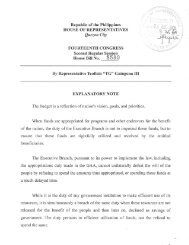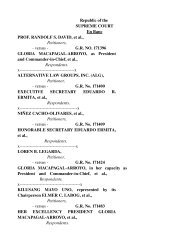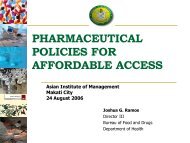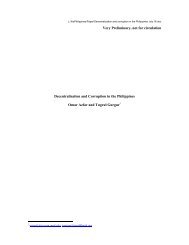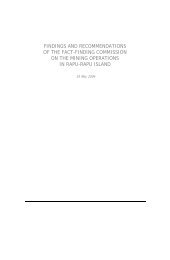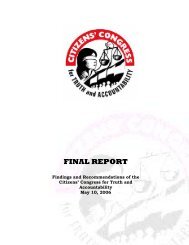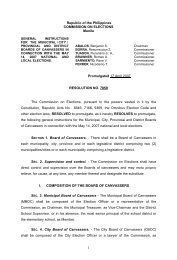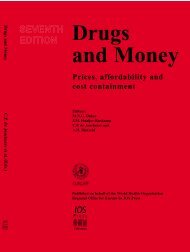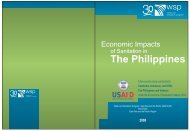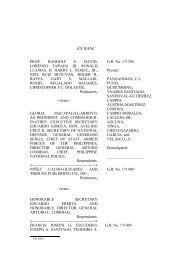The state of water resources in the Philippines - Greenpeace
The state of water resources in the Philippines - Greenpeace
The state of water resources in the Philippines - Greenpeace
You also want an ePaper? Increase the reach of your titles
YUMPU automatically turns print PDFs into web optimized ePapers that Google loves.
heavy precipitation events, which can <strong>in</strong>crease run<strong>of</strong>f <strong>in</strong> most areas as well as<br />
ground<strong>water</strong> recharge <strong>in</strong> some floodpla<strong>in</strong>s.<br />
Occurrences <strong>of</strong> extreme climatic events like droughts and floods have serious<br />
negative implications for major <strong>water</strong> reservoirs <strong>in</strong> <strong>the</strong> country as well, as shown<br />
<strong>in</strong> a study conducted <strong>in</strong> five major reservoirs <strong>in</strong> Luzon and one reservoir <strong>in</strong><br />
M<strong>in</strong>danao (Crisis and Opportunity).<br />
More cold, La Niña-type episodes were observed dur<strong>in</strong>g <strong>the</strong> 70s, while <strong>the</strong> 80s<br />
and 90s were characterized by <strong>the</strong> occurrence <strong>of</strong> four strong, warm periods<br />
(1982-83, 1986-87, 1991-92 and <strong>the</strong> 1997-98 El N<strong>in</strong>o events) caus<strong>in</strong>g consistent<br />
negative anomalies <strong>of</strong> ra<strong>in</strong>fall and <strong>in</strong>flow.<br />
<strong>The</strong> expected climate changes that could affect ra<strong>in</strong>fall distribution will ultimately<br />
affect run<strong>of</strong>f to rivers and lakes. On <strong>the</strong> o<strong>the</strong>r hand, decrease <strong>in</strong> run<strong>of</strong>f because<br />
<strong>of</strong> frequent drought episodes, would mean more serious problems <strong>in</strong> <strong>water</strong><br />
availability.<br />
IV. Legal and policy framework relat<strong>in</strong>g to <strong>water</strong> quality control, use and<br />
management<br />
A. Policies perta<strong>in</strong><strong>in</strong>g to <strong>water</strong> use and management<br />
One <strong>of</strong> <strong>the</strong> earliest attempts at systematic management <strong>of</strong> <strong>water</strong> has been <strong>the</strong><br />
adoption <strong>of</strong> a National Water Code <strong>in</strong> 1976 Presidential Decree 1067 (1976)<br />
(EMB, Philipp<strong>in</strong>e Country Assessment, p. 3).<br />
Accord<strong>in</strong>g to this report, <strong>the</strong> Code def<strong>in</strong>es <strong>the</strong> follow<strong>in</strong>g:<br />
1. <strong>the</strong> basic pr<strong>in</strong>ciples and structural framework relat<strong>in</strong>g to appropriation,<br />
control, conservation, and protection <strong>of</strong> <strong>water</strong> <strong>resources</strong> to achieve <strong>the</strong>ir<br />
optimum development and efficient use to meet present and future needs;<br />
2. <strong>the</strong> scope <strong>of</strong> <strong>the</strong> rights and obligations <strong>of</strong> <strong>water</strong> users and provides for <strong>the</strong><br />
protection and regulation <strong>of</strong> such rights; and<br />
3. <strong>the</strong> necessary adm<strong>in</strong>istrative mach<strong>in</strong>ery.<br />
O<strong>the</strong>r related laws are outl<strong>in</strong>ed <strong>in</strong> Table 5 (next page).<br />
GREENPEACE | <strong>The</strong> <strong>state</strong> <strong>of</strong> <strong>water</strong> <strong>in</strong> <strong>the</strong> Philipp<strong>in</strong>es 32



